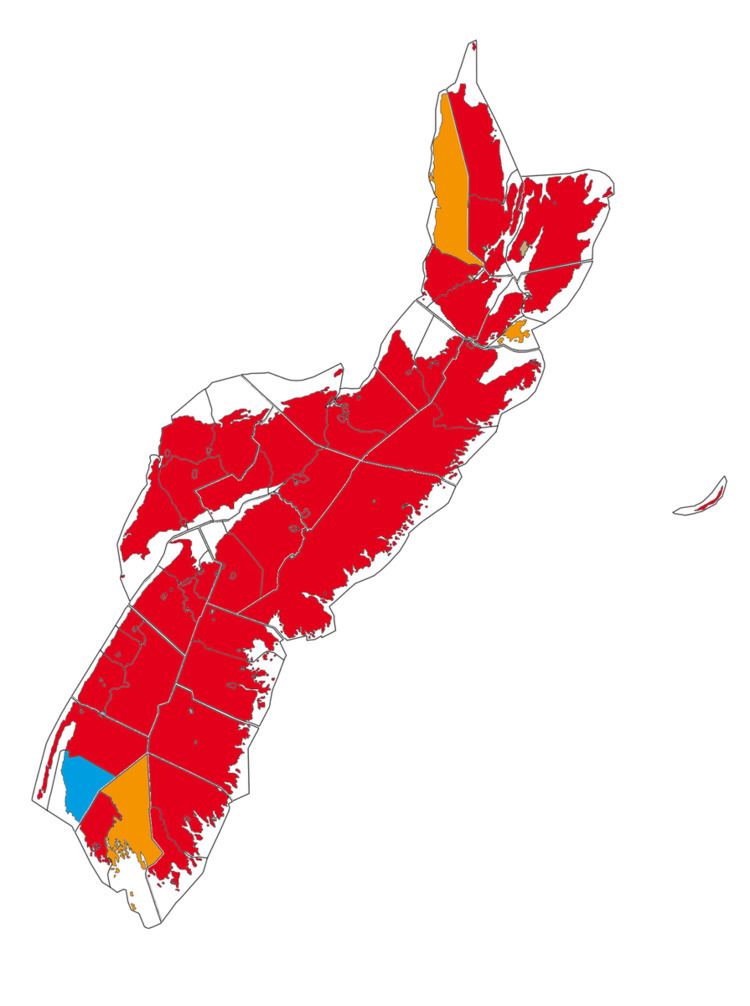 | ||
Nova Scotia (Latin for New Scotland; French: Nouvelle-Écosse; Scottish Gaelic: Alba Nuadh) is a Canadian province located on Canada's southeastern coast. It is the most populous province in the Atlantic Canada, and its capital, Halifax, is a major economic centre of the region. Nova Scotia is the second smallest province in Canada, with an area of 55,284 km². Its population of 921,727 makes it the fourth least populous province of the country.
Contents
Population
Nova Scotia is the seventh most populous province in Canada with an estimated 921,727 residents as of 2011. It accounts for 3 percent of the population of Canada. The population density is approximately 17.2 persons/km². Roughly 60% of the population live in rural parts of the province.
Regional municipalities
Nova Scotia has three regional municipalities.
Towns
Nova Scotia has 28 towns, not including the former Town of Canso that dissolved to become part of Guysborough County on July 1, 2012 and the former Towns of Bridgetown and Springhill which dissolved on April 1, 2015.
Population centres
The Halifax population centre is the largest urban area in Nova Scotia. Statistics Canada recognizes a total of 37 population centres in the province.
Population of Nova Scotia since 1851
Source: Statistics Canada
* among provinces.
** Preliminary 2006 census estimate.
Languages
The 2011 Canadian census showed a population of 921,727.
Of the 904,285 singular responses to the census question concerning mother tongue the most commonly reported languages were:
There were also 275 single-language responses for Turkish; 195 for Non-verbal languages (Sign languages); 30 for Malay; 100 for Bantu languages; 70 for Kurdish; 120 for Slovak; and 5 for Estonian. Figures shown are for the number of single language responses and the percentage of total single-language responses.
Immigration
The 2006 Canadian census counted a total of 45,195 immigrants living in Nova Scotia.
The most commonly reported origins for these immigrants were:
There were also 365 immigrants from Australia; 320 from South Africa; 280 from Hong Kong; 255 from Saudi Arabia; 245 from Iraq and from Trinidad and Tobago; 225 from Hungary and from Russia; 220 from Portugal; 215 from Switzerland; 210 from Denmark; and 205 from Belize.
Internal migration
A total of 101,035 people moved to Nova Scotia from other parts of Canada between 1996 and 2006 while 110,335 people moved in the opposite direction. These movements resulted in a net outmigration of 11,925 people to Alberta and 4,120 to Ontario; as well as a net influx of 4,690 people from Newfoundland and Labrador and 2,930 from New Brunswick. During this period there was a net outmigration of 835 francophones to Quebec and 340 to Alberta; and a net influx of 575 anglophones from Quebec and 145 francophones from New Brunswick. (All net inter-provincial movements of more than 500 persons and official minority movements of more than 100 persons are given.)
Religion
According to the 2001 census 36.5% of Nova Scotians were Roman Catholic, while 15.9% belonged to the United Church of Canada and 13.4% were Anglican. About 10.6% of the population identified as Baptist, 2.5% as Presbyterian, 1.7% as Protestant, 1.2% as Lutheran, 1.1% as Christian, and 1.0% as Pentecostal. 0.5% of the population reported belonging to the Jehovah's Witnesses, and 0.4% to the Salvation Army; while 0.4% identified as Muslim, 0.3% as Mormon, 0.2% as Wesleyan, 0.2% as Jewish, 0.2% as Greek Orthodox, 0.2% as Buddhist, and 0.2% as Seventh-day Adventist. 11.6% said they had no religion.
Employment
As of November 2009, the unemployment rate is 9.2 percent.
Gross domestic product
Nova Scotia GDP is presently approximately $33 billion (Can) annually.
